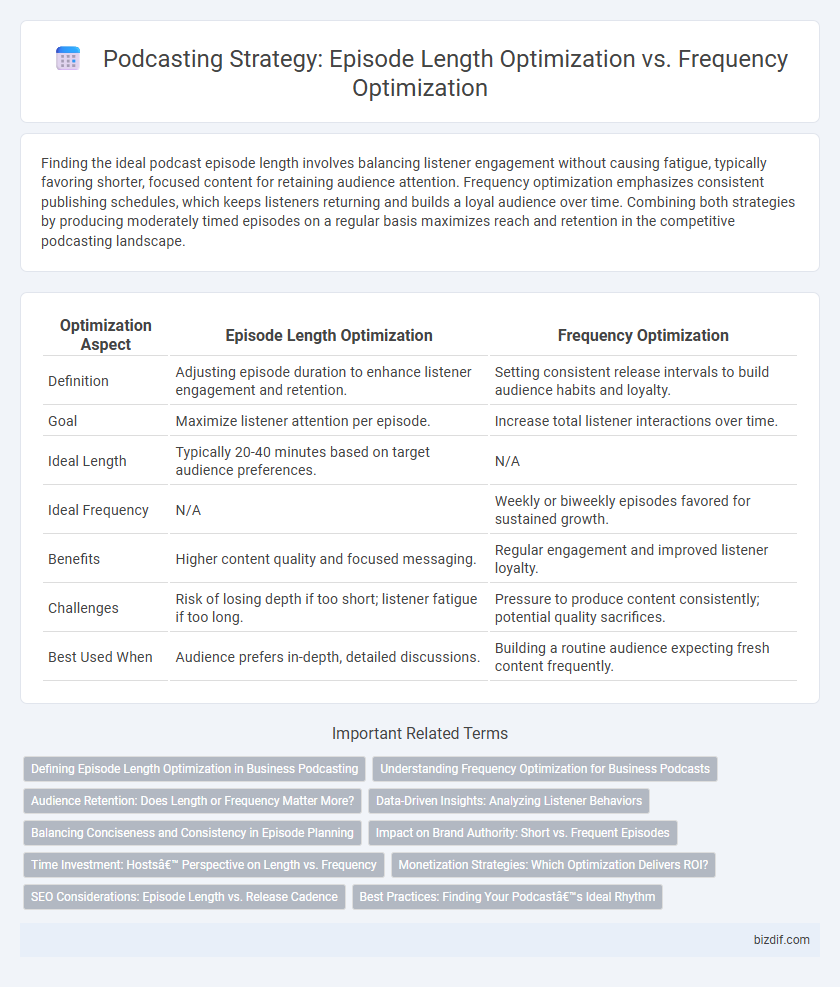Finding the ideal podcast episode length involves balancing listener engagement without causing fatigue, typically favoring shorter, focused content for retaining audience attention. Frequency optimization emphasizes consistent publishing schedules, which keeps listeners returning and builds a loyal audience over time. Combining both strategies by producing moderately timed episodes on a regular basis maximizes reach and retention in the competitive podcasting landscape.
Table of Comparison
| Optimization Aspect | Episode Length Optimization | Frequency Optimization |
|---|---|---|
| Definition | Adjusting episode duration to enhance listener engagement and retention. | Setting consistent release intervals to build audience habits and loyalty. |
| Goal | Maximize listener attention per episode. | Increase total listener interactions over time. |
| Ideal Length | Typically 20-40 minutes based on target audience preferences. | N/A |
| Ideal Frequency | N/A | Weekly or biweekly episodes favored for sustained growth. |
| Benefits | Higher content quality and focused messaging. | Regular engagement and improved listener loyalty. |
| Challenges | Risk of losing depth if too short; listener fatigue if too long. | Pressure to produce content consistently; potential quality sacrifices. |
| Best Used When | Audience prefers in-depth, detailed discussions. | Building a routine audience expecting fresh content frequently. |
Defining Episode Length Optimization in Business Podcasting
Episode length optimization in business podcasting involves tailoring the duration of each episode to match audience engagement patterns and content complexity, ensuring maximum retention and value delivery. Research indicates that episodes between 20 to 40 minutes often balance depth and listener attention span effectively within professional markets. This strategy contrasts with frequency optimization, emphasizing consistent, shorter releases that prioritize regular audience touchpoints over extended discussions.
Understanding Frequency Optimization for Business Podcasts
Frequency optimization in business podcasts involves strategically scheduling episode releases to maintain consistent audience engagement and build listener loyalty. Releasing episodes weekly or biweekly helps establish routine touchpoints that align with audience habits, enhancing retention and brand recall. Balancing frequency with content quality ensures sustained growth and measurable impact on marketing objectives.
Audience Retention: Does Length or Frequency Matter More?
Podcast episode length directly impacts audience retention by balancing depth of content with listener attention spans, while frequency influences habit formation and consistent engagement. Studies indicate that shorter episodes (15-30 minutes) tend to maintain higher completion rates, but frequent releases (weekly or biweekly) foster loyal, returning listeners. Prioritizing episode length to match audience preferences, combined with a reliable publishing schedule, maximizes retention and long-term growth.
Data-Driven Insights: Analyzing Listener Behaviors
Analyzing listener behaviors reveals that episode length optimization directly impacts audience retention rates, with studies showing episodes between 20-30 minutes yield the highest completion percentages. Frequency optimization, measured by regular weekly releases, correlates strongly with increased subscriber growth and consistent engagement metrics. Data-driven insights highlight that balancing optimal episode duration with a predictable publishing schedule maximizes overall listener satisfaction and platform algorithm favorability.
Balancing Conciseness and Consistency in Episode Planning
Balancing conciseness and consistency in podcast episode planning requires optimizing both episode length and release frequency to match audience preferences and listening habits. Shorter episodes around 20-30 minutes often enhance engagement, while maintaining a regular schedule, such as weekly or biweekly releases, builds listener loyalty and anticipation. Analyzing listener data and feedback helps creators find the ideal combination that maximizes retention and growth.
Impact on Brand Authority: Short vs. Frequent Episodes
Short episodes enable frequent releases, helping maintain consistent audience engagement and reinforcing brand presence regularly. Frequent podcast episodes build trust and authority by demonstrating reliability and dedication to delivering valuable content. Optimizing episode length and release frequency strategically enhances brand authority through sustained listener connection and content freshness.
Time Investment: Hosts’ Perspective on Length vs. Frequency
Podcast hosts weigh time investment when balancing episode length versus frequency, as longer episodes demand more preparation and editing but offer deeper content, while frequent shorter episodes require consistent scheduling and maintenance. Optimizing episode length allows hosts to deliver comprehensive discussions that engage listeners without overwhelming their production capacity. Conversely, focusing on frequency helps maintain audience interest and show momentum, though it necessitates disciplined time management to sustain regular releases.
Monetization Strategies: Which Optimization Delivers ROI?
Episode length optimization targets listener retention by balancing content depth and engagement, while frequency optimization increases touchpoints to build audience loyalty. Monetization strategies often yield higher ROI when frequency is optimized, as frequent episodes generate consistent ad impressions and sponsorship opportunities. Data shows podcasts releasing multiple episodes weekly tend to attract more advertisers, enhancing revenue potential compared to fewer, longer episodes.
SEO Considerations: Episode Length vs. Release Cadence
Optimizing episode length and release frequency both impact podcast SEO by influencing audience engagement and search ranking. Shorter episodes released consistently can improve listener retention and boost search visibility through regular content indexing, while longer episodes may deepen topic authority but risk lower completion rates. Balancing episode duration with a strategic release cadence enhances discoverability by aligning with algorithm preferences for fresh, engaging content.
Best Practices: Finding Your Podcast’s Ideal Rhythm
Balancing episode length and release frequency is crucial for maintaining audience engagement in podcasting. Data indicates that episodes between 20 to 40 minutes attract the most consistent listener retention, while weekly release schedules maximize subscriber growth and ad revenue potential. Implementing analytics tools to monitor listener drop-off rates and feedback helps podcasters refine their content delivery to match audience preferences effectively.
Episode Length Optimization vs Frequency Optimization Infographic

 bizdif.com
bizdif.com